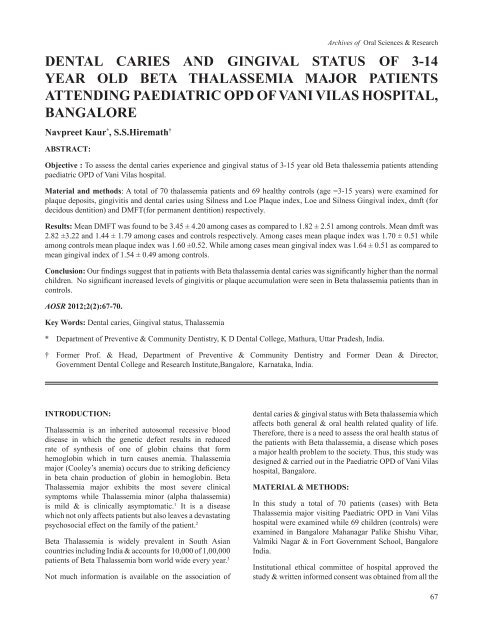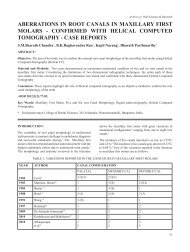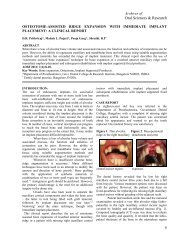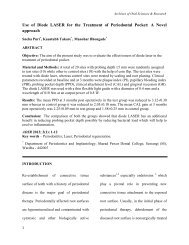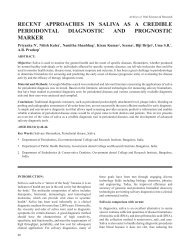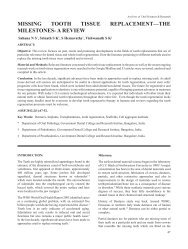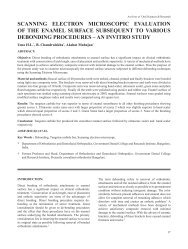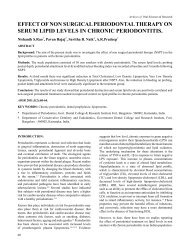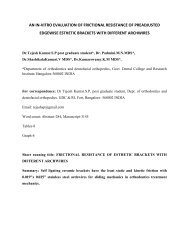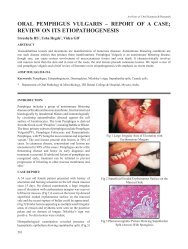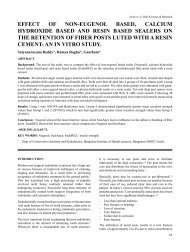dental caries and gingival status of 3-14 year old beta ... - Aosr.co.in
dental caries and gingival status of 3-14 year old beta ... - Aosr.co.in
dental caries and gingival status of 3-14 year old beta ... - Aosr.co.in
Create successful ePaper yourself
Turn your PDF publications into a flip-book with our unique Google optimized e-Paper software.
Archives <strong>of</strong> Oral Sciences & Research<br />
DENTAL CARIES AND GINGIVAL STATUS OF 3-<strong>14</strong><br />
YEAR OLD BETA THALASSEMIA MAJOR PATIENTS<br />
ATTENDING PAEDIATRIC OPD OF VANI VILAS HOSPITAL,<br />
BANGALORE<br />
Navpreet Kaur * , S.S.Hiremath †<br />
ABSTRACT:<br />
Objective : To assess the <strong>dental</strong> <strong>caries</strong> experience <strong>and</strong> <strong>g<strong>in</strong>gival</strong> <strong>status</strong> <strong>of</strong> 3-15 <strong>year</strong> <strong>old</strong> Beta thalessemia patients attend<strong>in</strong>g<br />
paediatric OPD <strong>of</strong> Vani Vilas hospital.<br />
Material <strong>and</strong> methods: A total <strong>of</strong> 70 thalassemia patients <strong>and</strong> 69 healthy <strong>co</strong>ntrols (age =3-15 <strong>year</strong>s) were exam<strong>in</strong>ed for<br />
plaque deposits, g<strong>in</strong>givitis <strong>and</strong> <strong>dental</strong> <strong>caries</strong> us<strong>in</strong>g Silness <strong>and</strong> Loe Plaque <strong>in</strong>dex, Loe <strong>and</strong> Silness G<strong>in</strong>gival <strong>in</strong>dex, dmft (for<br />
decidous dentition) <strong>and</strong> DMFT(for permanent dentition) respectively.<br />
Results: Mean DMFT was found to be 3.45 ± 4.20 among cases as <strong>co</strong>mpared to 1.82 ± 2.51 among <strong>co</strong>ntrols. Mean dmft was<br />
2.82 ±3.22 <strong>and</strong> 1.44 ± 1.79 among cases <strong>and</strong> <strong>co</strong>ntrols respectively. Among cases mean plaque <strong>in</strong>dex was 1.70 ± 0.51 while<br />
among <strong>co</strong>ntrols mean plaque <strong>in</strong>dex was 1.60 ±0.52. While among cases mean <strong>g<strong>in</strong>gival</strong> <strong>in</strong>dex was 1.64 ± 0.51 as <strong>co</strong>mpared to<br />
mean <strong>g<strong>in</strong>gival</strong> <strong>in</strong>dex <strong>of</strong> 1.54 ± 0.49 among <strong>co</strong>ntrols.<br />
Conclusion: Our f<strong>in</strong>d<strong>in</strong>gs suggest that <strong>in</strong> patients with Beta thalassemia <strong>dental</strong> <strong>caries</strong> was significantly higher than the normal<br />
children. No significant <strong>in</strong>creased levels <strong>of</strong> g<strong>in</strong>givitis or plaque accumulation were seen <strong>in</strong> Beta thalassemia patients than <strong>in</strong><br />
<strong>co</strong>ntrols.<br />
AOSR 2012;2(2):67-70.<br />
Key Words: Dental <strong>caries</strong>, G<strong>in</strong>gival <strong>status</strong>, Thalassemia<br />
* Department <strong>of</strong> Preventive & Community Dentistry, K D Dental College, Mathura, Uttar Pradesh, India.<br />
† Former Pr<strong>of</strong>. & Head, Department <strong>of</strong> Preventive & Community Dentistry <strong>and</strong> Former Dean & Director,<br />
Government Dental College <strong>and</strong> Research Institute,Bangalore, Karnataka, India.<br />
INTRODUCTION:<br />
Thalassemia is an <strong>in</strong>herited autosomal recessive blood<br />
disease <strong>in</strong> which the genetic defect results <strong>in</strong> reduced<br />
rate <strong>of</strong> synthesis <strong>of</strong> one <strong>of</strong> glob<strong>in</strong> cha<strong>in</strong>s that form<br />
hemoglob<strong>in</strong> which <strong>in</strong> turn causes anemia. Thalassemia<br />
major (Cooley’s anemia) occurs due to strik<strong>in</strong>g deficiency<br />
<strong>in</strong> <strong>beta</strong> cha<strong>in</strong> production <strong>of</strong> glob<strong>in</strong> <strong>in</strong> hemoglob<strong>in</strong>. Beta<br />
Thalassemia major exhibits the most severe cl<strong>in</strong>ical<br />
symptoms while Thalassemia m<strong>in</strong>or (alpha thalassemia)<br />
is mild & is cl<strong>in</strong>ically asymptomatic. 1 It is a disease<br />
which not only affects patients but also leaves a devastat<strong>in</strong>g<br />
psychosocial effect on the family <strong>of</strong> the patient. 2<br />
Beta Thalassemia is widely prevalent <strong>in</strong> South Asian<br />
<strong>co</strong>untries <strong>in</strong>clud<strong>in</strong>g India & ac<strong>co</strong>unts for 10,000 <strong>of</strong> 1,00,000<br />
patients <strong>of</strong> Beta Thalassemia born world wide every <strong>year</strong>. 3<br />
Not much <strong>in</strong>formation is available on the association <strong>of</strong><br />
<strong>dental</strong> <strong>caries</strong> & <strong>g<strong>in</strong>gival</strong> <strong>status</strong> with Beta thalassemia which<br />
affects both general & oral health related quality <strong>of</strong> life.<br />
Therefore, there is a need to assess the oral health <strong>status</strong> <strong>of</strong><br />
the patients with Beta thalassemia, a disease which poses<br />
a major health problem to the society. Thus, this study was<br />
designed & carried out <strong>in</strong> the Paediatric OPD <strong>of</strong> Vani Vilas<br />
hospital, Bangalore.<br />
MATERIAL & METHODS:<br />
In this study a total <strong>of</strong> 70 patients (cases) with Beta<br />
Thalassemia major visit<strong>in</strong>g Paediatric OPD <strong>in</strong> Vani Vilas<br />
hospital were exam<strong>in</strong>ed while 69 children (<strong>co</strong>ntrols) were<br />
exam<strong>in</strong>ed <strong>in</strong> Bangalore Mahanagar Palike Shishu Vihar,<br />
Valmiki Nagar & <strong>in</strong> Fort Government School, Bangalore<br />
India.<br />
Institutional ethical <strong>co</strong>mmittee <strong>of</strong> hospital approved the<br />
study & written <strong>in</strong>formed <strong>co</strong>nsent was obta<strong>in</strong>ed from all the<br />
67
Navpreet Kaur et al.<br />
study participants <strong>and</strong> parents <strong>of</strong> children participat<strong>in</strong>g <strong>in</strong><br />
the study before their exam<strong>in</strong>ation. The study was carried<br />
out from February 2007 to June 2007.<br />
Inclusion criteria were:<br />
1. Age group between 3 & <strong>14</strong> <strong>year</strong>s.<br />
2. Only those patients who were diagnosed previously<br />
for Beta Thalassemia major were <strong>co</strong>nsidered as<br />
cases.<br />
3. Match<strong>in</strong>g <strong>of</strong> age, sex & socioe<strong>co</strong>nomic <strong>status</strong> <strong>of</strong><br />
cases & <strong>co</strong>ntrols.<br />
4. The <strong>co</strong>ntrols were free <strong>of</strong> thalassemia, both the<br />
major <strong>and</strong> m<strong>in</strong>or forms.<br />
Exclusion criteria were:<br />
1. Those seek<strong>in</strong>g <strong>dental</strong> treatment.<br />
2. Those suffer<strong>in</strong>g from other diseases known to<br />
<strong>in</strong>fluence <strong>dental</strong> <strong>caries</strong> or severity <strong>of</strong> periodontal<br />
disease such as diabetes.<br />
The study <strong>co</strong>nsisted <strong>of</strong> an <strong>in</strong>terview & <strong>in</strong>traoral<br />
exam<strong>in</strong>ation<br />
In oral exam<strong>in</strong>ation follow<strong>in</strong>g <strong>in</strong>dices were be<strong>in</strong>g used:<br />
1. DMFT <strong>in</strong>dex for permanent teeth 4 & dmft <strong>in</strong>dex<br />
for primary teeth 5 to re<strong>co</strong>rd <strong>dental</strong> <strong>caries</strong><br />
experience.<br />
2. Plaque <strong>in</strong>dex given by Silness & Loe. 6<br />
3. G<strong>in</strong>gival <strong>in</strong>dex given by Loe & Silness. 7<br />
Plaque <strong>in</strong>dex & G<strong>in</strong>gival <strong>in</strong>dex were modified ac<strong>co</strong>rd<strong>in</strong>g<br />
to criteria where<strong>in</strong> for primary dentition, teeth 54, 64, 74,<br />
84, 71 <strong>and</strong> 81 were evaluated. In the case <strong>of</strong> permanent<br />
dentition, teeth 16, 26, 36, 46, 31 <strong>and</strong> 41 were evaluated.<br />
In mixed dentition cases, <strong>in</strong> the previous sector, teeth<br />
were substituted by the successive permanent ones, <strong>and</strong><br />
<strong>in</strong> the posterior sector, the first permanent molars were<br />
evaluated. 8<br />
Plane mouth mirror & explorer were used to exam<strong>in</strong>e the<br />
oral cavity. Autoclaved <strong>in</strong>struments were used for oral<br />
exam<strong>in</strong>ation <strong>of</strong> subjects. S<strong>in</strong>gle exam<strong>in</strong>er & s<strong>in</strong>gle re<strong>co</strong>rder<br />
were ma<strong>in</strong>ta<strong>in</strong>ed throughout the study period.<br />
Statistical analysis was done us<strong>in</strong>g statistical s<strong>of</strong>tware * . Chi<br />
square test & student t test was used for the <strong>co</strong>mparison <strong>of</strong><br />
study <strong>and</strong> <strong>co</strong>ntrol groups. The level <strong>of</strong> significance was set<br />
at p
Dental <strong>caries</strong> & G<strong>in</strong>gival Status <strong>of</strong> ß Thalassemia Major Patients<br />
dmft (p value < 0.05) (Table 3).<br />
Mean total DMFT among males was 2.58 ± 3.61 as<br />
<strong>co</strong>mpared to mean total DMFT <strong>of</strong> 2.79 ± 3.47 among<br />
females. There was no significant difference between<br />
males <strong>and</strong> females for mean <strong>g<strong>in</strong>gival</strong> <strong>in</strong>dex (Fig 2).<br />
DISCUSSION:<br />
The present study was <strong>co</strong>nducted <strong>in</strong> an attempt to assess<br />
<strong>dental</strong> <strong>caries</strong> <strong>and</strong> <strong>g<strong>in</strong>gival</strong> <strong>status</strong> among <strong>in</strong>dividuals<br />
suffer<strong>in</strong>g from <strong>beta</strong> thalassemia.<br />
Distribution ac<strong>co</strong>rd<strong>in</strong>g to mean DMFT:<br />
When mean DMFT was <strong>co</strong>mpared between the cases<br />
<strong>and</strong> <strong>co</strong>ntrols it was found to be 3.45±4.20 among cases<br />
as <strong>co</strong>mpared to 1.82±2.51 among <strong>co</strong>ntrols.<br />
Mean DMFT s<strong>co</strong>re was significantly higher <strong>in</strong> case<br />
group <strong>co</strong>mpared to <strong>co</strong>ntrol group which is similar to<br />
study <strong>co</strong>nducted by Al- Wahadni A M, Taani D Q,<br />
Al- Omari M O 1 <strong>and</strong> <strong>in</strong> another study <strong>co</strong>nducted by<br />
Sunil Gomber <strong>and</strong> Pooja Dewan. 9<br />
Distribution ac<strong>co</strong>rd<strong>in</strong>g to mean dmft:<br />
When mean dmft was <strong>co</strong>mpared between the cases<br />
<strong>and</strong> <strong>co</strong>ntrols it was found to be 2.82±3.22 among cases<br />
as <strong>co</strong>mpared to 1.44±1.79 among <strong>co</strong>ntrols.<br />
females. The difference regard<strong>in</strong>g mean total DMFT<br />
among males <strong>and</strong> females was <strong>in</strong>significant (Fig 1).<br />
Mean total dmft among males was 2.11 ± 2.60<br />
<strong>co</strong>mpared to mean total dmft <strong>of</strong> 2.21 ± 2.91 among<br />
females.There was no significant difference between<br />
males <strong>and</strong> females for mean total dmft (Fig 2)<br />
Among cases mean plaque <strong>in</strong>dex was 1.70 ± 0.51 while<br />
among <strong>co</strong>ntrols mean plaque <strong>in</strong>dex was 1.60±0.52.<br />
There was no significant difference between cases <strong>and</strong><br />
<strong>co</strong>ntrols regard<strong>in</strong>g mean plaque <strong>in</strong>dex (Table 4).<br />
While among cases mean <strong>g<strong>in</strong>gival</strong> <strong>in</strong>dex was 1.64±<br />
0.51 as <strong>co</strong>mpared to mean <strong>g<strong>in</strong>gival</strong> <strong>in</strong>dex <strong>of</strong> 1.54±0.49<br />
among <strong>co</strong>ntrols.No significant difference for mean<br />
<strong>g<strong>in</strong>gival</strong> <strong>in</strong>dex was found between cases <strong>and</strong> <strong>co</strong>ntrols<br />
(Table 4).<br />
Mean plaque <strong>in</strong>dex among males was 1.66±0.52<br />
when <strong>co</strong>mpared to females where it was 1.63±0.51.<br />
There was no significant difference between males <strong>and</strong><br />
females regard<strong>in</strong>g mean plaque <strong>in</strong>dex (Fig 2).<br />
While when mean <strong>g<strong>in</strong>gival</strong> <strong>in</strong>dex was <strong>co</strong>mpared it was<br />
found to be 1.61± 0.50 among males <strong>and</strong> 1.54 ± 0.49 among<br />
Mean dmft s<strong>co</strong>re was significantly higher <strong>in</strong> case group<br />
<strong>co</strong>mpared to <strong>co</strong>ntrol group which is similar to study<br />
<strong>co</strong>nducted by Al- Wahadni A M, Taani D Q, Al- Omari<br />
MO 1 <strong>and</strong> <strong>in</strong> another study <strong>co</strong>nducted by Sunil Gomber<br />
<strong>and</strong> Pooja Dewan. 9 However, study by Scutellori et<br />
al 10 found similar <strong>dental</strong> <strong>caries</strong> experience among<br />
<strong>beta</strong> thalassemia subjects <strong>and</strong> <strong>co</strong>ntrols.<br />
The patients with Beta thalassemia had higher <strong>caries</strong><br />
experience than the normal children. Level <strong>of</strong> <strong>dental</strong><br />
<strong>caries</strong> may be expla<strong>in</strong>ed on the basis <strong>of</strong> chronic nature<br />
<strong>of</strong> thalassemia. Patients preoccupied with their ma<strong>in</strong>, life<br />
threaten<strong>in</strong>g problem, neglect basic preventive <strong>dental</strong> care.<br />
Lack <strong>of</strong> oral health knowledge, poor motivation <strong>of</strong> these<br />
subjects are also the attributable causes. Most <strong>of</strong> their<br />
needs for restoration go unmet due to f<strong>in</strong>ancial <strong>status</strong> &<br />
other limitations <strong>in</strong>clud<strong>in</strong>g time. The DMFT s<strong>co</strong>res reveal<br />
that active <strong>dental</strong> disease is present among cases.<br />
Genderwise distribution <strong>of</strong> DMFT <strong>and</strong> dmft:<br />
Mean total DMFT among males was 2.58± 3.61 as <strong>co</strong>mpared<br />
to mean total DMFT <strong>of</strong> 2.79±3.47 among females.<br />
Mean total dmft among males was 2.11±2.60 as <strong>co</strong>mpared<br />
to mean total dmft <strong>of</strong> 2.21±2.91 among females.<br />
G<strong>in</strong>gival <strong>status</strong> <strong>of</strong> the sample population as measured<br />
by Plaque <strong>in</strong>dex <strong>and</strong> G<strong>in</strong>gival <strong>in</strong>dex:<br />
Mean plaque <strong>in</strong>dex was 1.70±0.51 while among <strong>co</strong>ntrols<br />
mean plaque <strong>in</strong>dex was 1.60±0.52. While among cases<br />
mean <strong>g<strong>in</strong>gival</strong> <strong>in</strong>dex was 1.64±0.51 as <strong>co</strong>mpared to mean<br />
69
Navpreet Kaur et al.<br />
<strong>g<strong>in</strong>gival</strong> <strong>in</strong>dex <strong>of</strong> 1.54±0.49 among <strong>co</strong>ntrols.<br />
The results were similar to study <strong>co</strong>nducted by Al-<br />
Wahadni A M, Taani D Q, Al- Omari M O1 <strong>in</strong> which <strong>beta</strong><br />
thalassemia was not associated with significant <strong>in</strong>creased<br />
levels <strong>of</strong> g<strong>in</strong>givitis.<br />
Gender wise distribution <strong>of</strong> Plaque <strong>in</strong>dex <strong>and</strong> G<strong>in</strong>gival<br />
<strong>in</strong>dex:<br />
Mean plaque <strong>in</strong>dex among males was 1.66±0.52 when<br />
<strong>co</strong>mpared to females where it was 1.63±0.51.While when<br />
mean <strong>g<strong>in</strong>gival</strong> <strong>in</strong>dex was <strong>co</strong>mpared it was found to be<br />
1.61±0.50 among males <strong>and</strong> 1.54±0.49 among females.<br />
CONCLUSION:<br />
The patients with Beta thalassemia had higher <strong>caries</strong><br />
experience prevalence than the healthy <strong>co</strong>ntrols. No<br />
significant <strong>in</strong>creased levels <strong>of</strong> g<strong>in</strong>givitis or plaque<br />
accumulation were seen <strong>in</strong> Beta thalassemia patients than<br />
<strong>in</strong> <strong>co</strong>ntrols. However, oral health education to improve<br />
oral hygiene is important to be given to <strong>beta</strong> thalassemia<br />
patients to prevent <strong>dental</strong> diseases. Also, such patients<br />
should receive regular follow up care <strong>and</strong> timely <strong>dental</strong><br />
treatment.<br />
REFERENCES:<br />
1. Al-Wahadni AM, Taani DQ, Al Omari MO. Dental<br />
diseases <strong>in</strong> subjects with <strong>beta</strong> thalassemia major.<br />
Community Dent Oral Epidemiol 2002; 30:418-422.<br />
2. White & Pharoah. Oral Radiology Pr<strong>in</strong>ciples &<br />
Interpretation. Elsevier, 5 th edition :533-536.<br />
3. H. M .Worth. Pr<strong>in</strong>ciples <strong>and</strong> practice <strong>of</strong> oral radiologic<br />
<strong>in</strong>terpretation. Year book medical publisher, 2 nd<br />
edition: 367-369.<br />
4. Henry Klien, Carrole E Palmer, Knutson JW. Studies<br />
on <strong>dental</strong> <strong>caries</strong>, <strong>dental</strong> <strong>status</strong> <strong>and</strong> <strong>dental</strong> needs <strong>of</strong><br />
elementary school children. Public health report<br />
(Wash<strong>in</strong>gton) 1938;53:751-765.<br />
5. Gruebbel AO. A measurement <strong>of</strong> <strong>dental</strong> <strong>caries</strong><br />
prevalence <strong>and</strong> treatment service for deciduous teeth. J<br />
Dent Res 1944; 23:163.<br />
6. Silness J, Loe H. Periodontal disease <strong>in</strong> pregnancy,<br />
part II. Correlation between oral hygiene <strong>and</strong> periodontal<br />
<strong>co</strong>ndition. Acta Odontol Sc<strong>and</strong> 1964;22:121-135.<br />
7. Loe H, Silness J. Periodontal disease <strong>in</strong> pregnancy<br />
part I, Prevalence <strong>and</strong> severity. Acta Odontol Sc<strong>and</strong><br />
1963;21:533-551.<br />
8. Viera NT, Rojas DE, Morales T, Navas RM, Zambrano<br />
OR, Paz DE Gud<strong>in</strong>o M. G<strong>in</strong>givitis <strong>and</strong> anti-neutrophil<br />
cytoplasmic antibodies <strong>in</strong> children & adolescents<br />
suffer<strong>in</strong>g from leukemia. Med Oral Patol Oral Cir<br />
Bucal 2004;9:396-402.<br />
9. Gomber S, Dewan P. Physical growth & <strong>dental</strong> <strong>caries</strong><br />
<strong>in</strong> thalassemia. Indian Pediatrics 2006;43:1064-<br />
1069.<br />
10. Scutellori PN, Orz<strong>in</strong><strong>co</strong>lo C, Andraghetti D, Gamberirni<br />
MR. Anomalies <strong>of</strong> the masticatory apparatus <strong>in</strong><br />
<strong>beta</strong> thalassemia, the present <strong>status</strong> after<br />
transfusion <strong>and</strong> iron chelat<strong>in</strong>g therapy. Radio Med<br />
1994;87:386-96.<br />
CORRESPONDENCE:<br />
Dr. Navpreet Kaur<br />
Senior Lecturer, Department <strong>of</strong> Preventive & Community Dentistry,<br />
K D Dental College, Mathura, Uttar Pradesh, India<br />
E mail: navpreet13879@yahoo.<strong>co</strong>.<strong>in</strong><br />
Ph: 09997870789, 09013434340<br />
70


